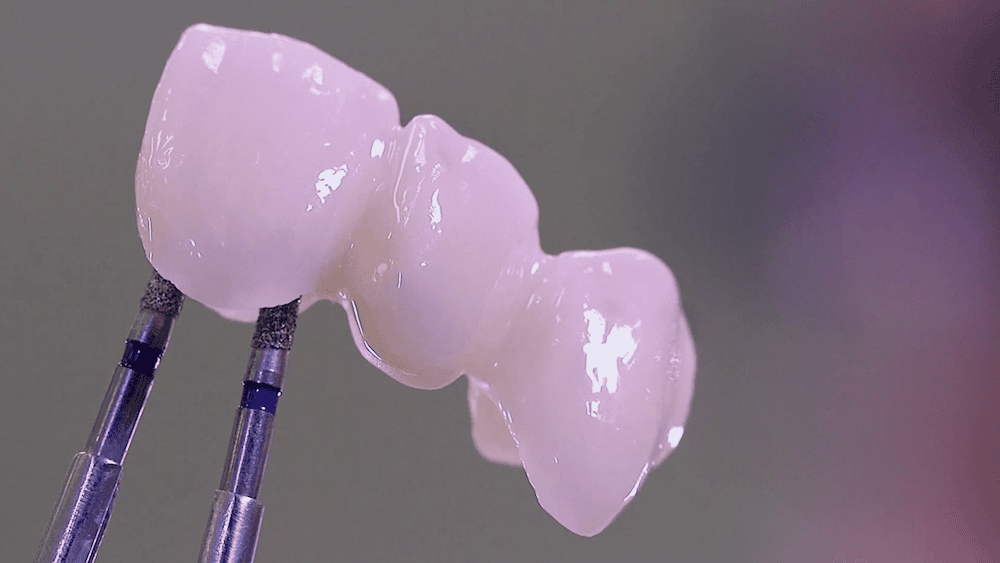
[Image above] Lithium disilicate, pictured above, is a glass-ceramic used commonly in dental work, but it is mechanically weak compared to other ceramics, like porcelain and zirconia. Researchers in Sweden developed a glass-ceramic made of zircon that is much stronger. Credit: Ivoclar Vivadent North America, YouTube
We are at that time of year where we regretfully say goodbye to candy canes and gingerbread and say hello to chocolate of every kind (I swear Valentine’s Day advertising begins earlier every year). For many of us, this transition between holidays signals the time we resign ourselves to an annual check-up at the dentist, to see what havoc our consumption of sugary treats over the last year did to our teeth.
For many people, there is reason to dread this annual visit. More than 90 percent of United States adults have some degree of tooth decay, and about 15 million people have crown and bridge replacements for missing teeth. Chances are high that your annual visit will turn into multiple visits and cost a pretty penny.
If you are one of those needing a new crown or bridge this year, you would likely prefer a material that lasts a long time without need for continued maintenance. For people who need a back molar replaced, that material is commonly a metal alloy because it does not fracture easily under the intense grinding experienced during chewing. But if you need a crown on a front tooth, then your dentist will likely use ceramics.
Porcelain-based ceramic crowns (and more recently zirconia crowns) do not risk an allergic reaction in patients who have an allergy to metal. However, the real reason people usually choose a ceramic crown over a metal one has more to do with aesthetics: ceramic-based crowns more closely match the color of natural teeth than metal-based crowns.
Though porcelain-based and zirconia ceramic crowns represent the best aesthetic match for teeth currently, dentists know of another material that does even better—glass-ceramics. Compared to porcelain-based and zirconia crowns, glass-ceramics offer an even better color match to surrounding natural teeth.
However, glass-ceramics are not nearly as strong as conventional ceramic crowns, and must be used in conjunction with resin bonding cements to even stand a chance at longevity. That is why, despite better aesthetics, glass-ceramics have not taken over the dental crown industry—but that could change soon.
Last October, researchers at Ångström Laboratory at Uppsala University in Sweden published a paper describing a new glass-ceramic they developed with enough strength to compete against conventional ceramics used in dental applications.
“The dilemma in dentistry today is that existing strong materials are white in colour (a white that does not look natural), and materials that are translucent are not as strong,” explains Wei Xia, who heads the research team along with Håkan Engqvist and Le Fu, in a press release. “Our ceramics are three times stronger and also translucent.”

Uppsala University researchers developed zircon glass-ceramics with flexural strength comparable to the strongest zirconia-based ceramic used in dental applications. The glass-ceramic’s strength is due to its zirconium-oxygen-silicon superlattice. Credit: Uppsala University, Reprinted with permission from Nano Lett., 2018, 18(11), pp 7146–7154. Copyright 2018 American Chemical Society.
In their research, Xia and his colleagues prepared zircon (ZrO2–SiO2) nanocrystalline glass-ceramics with a microstructure of monocrystalline zirconia nanoparticles, embedded in an amorphous silica matrix. When they measured the flexural strength of the material, they found it averaged 1 GPa. Not only is this value well above the average flexural strength of lithium disilicate, the most-common dental crown glass-ceramic (flexural strength anywhere between 200 to 500 MPa), this value is close to the strength of yttrium partially stabilized tetragonal zirconia (about 900 to 1,200 MPa), which is the strongest zirconia-based ceramic used in dental applications.
Notably, these zircon glass-ceramics achieved their flexural strength without the need for resin bonding cements. Instead, their strength came from the zirconia nanoparticles bonding strongly with the silica matrix to form a zirconium-oxygen-silicon superlattice.
While this finding won’t hit the market in time for your next dental implant, keep an eye out for such an option when your current porcelain ones need replaced in 5 to 15 years!
The paper, published in Nano Letters, is “Ultrastrong translucent glass ceramic with nanocrystalline, biomimetic structure” (DOI: 10.1103/PhysRevMaterials.3.013602).
Author
Lisa McDonald
CTT Categories
- Biomaterials & Medical
- Material Innovations


